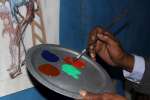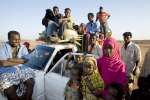South Korea - Refugee granted citizenship for first time
Briefing Notes, 23 March 2010
This is a summary of what was said by UNHCR spokesperson Melissa Fleming – to whom quoted text may be attributed – at the press briefing, on 23 March 2010, at the Palais des Nations in Geneva.
For the first time since the Republic of Korea adopted the 1951 Refugee Convention in 1992, a recognized refugee has been granted South Korean citizenship. The new citizen is a 38-year-old Ethiopian man who fled persecution in his homeland and arrived in South Korea in 2001.
This is a highly significant milestone in Asia, where few countries have signed the 1951 Refugee Convention, and even fewer have extended citizenship to refugees.
We are grateful to the Republic of Korea for its leadership in local integration, one of the three durable solutions available to refugees, and one that is rarely used in Asia. Citizenship is, of course, the most comprehensive form of local integration. We would be encouraged if other Asian countries took inspiration from South Korea's example.
South Korea recognized its first refugee in 2001. Since the government started receiving asylum claims in 1994, it has recognized 175 refugees and provided humanitarian status to a further 93 people who were found not to be refugees but still in need of international protection. Between 1994 and the end of 2009, the South Korean government received 2,492 applications and 321 are still pending.
East Africans continue to flood into the Arabian Peninsula
Every month, thousands of refugees, asylum-seekers and migrants from Somalia and Ethiopia cross the Gulf of Aden or the Red Sea to reach Yemen, fleeing drought, poverty, conflict or persecution. And although this year's numbers are, so far, lower than in 2012 - about 62,200 in the first 10 months compared to 88,533 for the same period last year - the Gulf of Aden remains one of the world's most travelled sea routes for irregular migration (asylum-seekers and migrants). UNHCR and its local partners monitor the coast to provide assistance to the new arrivals and transport them to reception centres. Those who make it to Yemen face many challenges and risks. The government regards Somalis as prima facie refugees and automatically grants them asylum, but other nationals such as the growing number of Ethiopians can face detention. Some of the Somalis make their own way to cities like Aden, but about 50 a day arrive at Kharaz Refugee Camp, which is located in the desert in southern Yemen. Photographer Jacob Zocherman recently visited the Yemen coast where arrivals land, and the camp where many end up.
East Africans continue to flood into the Arabian Peninsula
A Family of Somali Artists Continue to Create in Exile
During two decades of conflict and chaos in Somalia, Mohammed Ousman stayed in Mogadishu and taught art as others fled the country. But life became impossible after Al Shabaab militants killed his brother for continuing to practise art. Four of the man's nine children were also murdered. Mohammed closed his own "Picasso Art School" and married his brother's widow, in accordance with Somali custom. But without a job, the 57-year-old struggled to support two families and eventually this cost him his first family. Mohammed decided to leave, flying to Berbera in Somaliland in late 2011 and then crossing to Aw-Barre refugee camp in Ethiopia, where he joined his second wife and her five children. UNHCR transferred Mohammed and his family to Addis Ababa on protection grounds, and in the belief that he could make a living there from his art. But he's discovering that selling paintings and drawings can be tough - he relies on UNHCR support. The following images of the artist and his family were taken by UNHCR's Kisut Gebre Egziabher.
A Family of Somali Artists Continue to Create in Exile
New arrivals in Ethiopia: Remote Dolo Ado becomes a safe haven for 10,000 Somalis fleeing violence
Since the beginning of this year an estimated 10,000 Somalis have crossed the border and sought shelter in Dolo Ado, a remote, sun-scorched and predominantly Somali corner of south-east Ethiopia. Most have fled insecurity, following the withdrawal of Ethiopian troops from south and central Somalia and the takeover of these areas by insurgent elements. At the peak of the influx in early February 2009, about 150 people were crossing the border each day.
In reponse, a UNHCR emergency team was sent to help run a transit centre in Dolo Ado. In addition, UNHCR dispatched convoys carrying emergency aid, including mosquito nets, blankets, jerry cans, kitchen sets and plastic sheets. Relief efforts are being coordinated with other UN agencies and NGOs to ensure needs are being met.
Although a number of displaced Somalis within south and central Somalia have started to return, mainly to Mogadishu, many Somalis remain in Dolo Ado in need of protection. Given the poor prospects for repatriation in the foreseeable future, a camp is now under development and refugees are being screened.
New arrivals in Ethiopia: Remote Dolo Ado becomes a safe haven for 10,000 Somalis fleeing violence


Ethiopia: Far From Home
Nyabuka Lam arrived in Pagak, Ethiopia in September after escaping armed men who shot her three children and husband back in her home country, South Sudan. After walking for 15 days to reach the safety of Pagak, she is now finally on a path to recovery.


Canada: Light Years Ahead
With help from the Government of Canada, lives of refugees in Chad and Ethiopia have been transformed through the Light Years Ahead project.


Ethiopia: South Sudanese Refugee Influx
Despite a ceasefire agreement signed in early May, fighting continues between government and opposition forces in South Sudan. The renewed conflict has forced thousands of refugees to seek shelter in Ethiopia.
 |
|  |
|  |
| 

















































